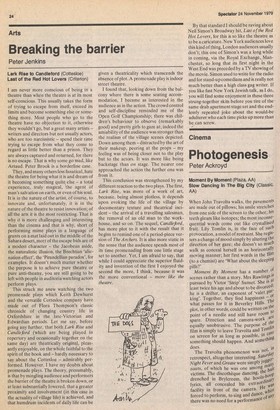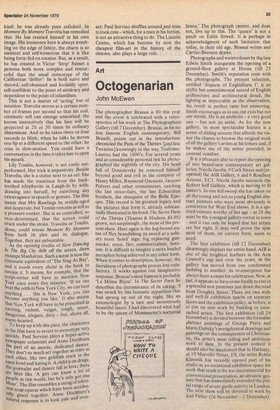Photogenesis
Peter Ackroyd
Moment By Moment (Plaza, AA) Slow Dancing In The Big City (Classic, AA) When John Travolta walks, the pavements are made out of pillows; his smile stretches from one side of the screen to the other; his teeth gleam like isotopes; the most inconsequential words come out like crystallised fruit. Lily Tomlin is, in the face of such provocation, a model of restraint. She registers a change of mood simply by altering the direction of her gaze; she doesn't so much walk as conceal herself in an horizontailY moving manner; her first words in the Mil (to a chemist) are 'What about the sleeping pills?' Moment By Moment has a number of scenes rather than a story. Mrs Rawlings is pursued by Victor 'Strip' Sunset. She is at least twice his age and about to be divorced; he is a drifter, an exponent of 'valet par" king'. Together, they find happiness — 01. what passes for it in Beverley Hills. The plot, in other words, could be written on the point of a needle and still have room t° spare. Direction and camera-work are equally. unobtrusive. The purpose of the film is simply to leave Travolta and Torn! on screen for as long as possible, in as' something should happen. And something does.
The Travolta phenomenon was no t retrospect, altogether interesting. Saturet Night Fever and Grease were simplY nauts, of which he was one among tuhilti'ir victims. The discotheque dancing, the drenched in Brylcreem, the hoola-ht", lyrics, all concealed his extraordinwara.; facility in front of the camera. He her, forced to perform, to sing and dance, w „ there was no need for a performance °f kind: he was already pure celluloid. In Moment By Moment Travolta has remedied that. He has created himself in his own image. His innocence here is always trembling on the edge of falsity, the charm is so insistent and selflronscious that it is like being force-fed on cocaine. But, as a result, he has created in Victor 'Strip' Sunset a persona both more complex and resourceful than the usual stereotype of the Californian 'drifter': he is both naive and shrewd, self-obsessed and foolishly open, self-confident to the point of stridency and dependent to the point of infantilism.
This is not a matter of 'acting' but of intuition. Travolta moves at a certain number of frames per second so that his real, cinematic self can emerge unscathed. He knows instinctively that his face will be projected at 20 or 30 times its ordinary dimensions. And so he takes three or four seconds to blink; when he talks he moves one lip at a different speed to the other; he cries in slow-motion. You could have a conversation in the time it takes him to open his mouth.
Lily Tomlin, however, is not easily outperformed. Her trick is impassivity. Beside Travolta, she is a statue next to an eel, She has made the transition from the bucktoothed telephonist in Laugh-In by withdrawing into herself, by exorcising any extravagance in speech or gesture. The film insists that Mrs Rawlings be middle-aged and desperate, but Tomlin remains as still as a pressure-cooker. She is so controlled, so over-determined, that the screen could crack under the strain. Travolta or Tomlin, alone, could rescue Moment By Moment from both its plot and its dialogue. Together, they are unbeatable. As the opening credits of Slow Dancing In The Big City drift off the screen, dawn swamps Manhattan. Such a scene is now the cinematic equivalent of 'The Stag At Bay', and it needs every cliche in the book to sustain it. It means, for example, that the script-writer will have to mention New York once every five minutes: 'If we can beat the odds in New York City, we can beat ,anything . this is New York, you can become anything you like,' It also means that New York will have to be presented as exciting, violent, vulgar, tough, smart, dangerous, elegant, dirty — but, above all, warm-hearted. To keep up with this pace, the characters in the film have to revert to stereotype very quickly. Paul Sorvino plays a hyper-active 11,ewspaper columnist and Anne Ditchburn .!ne part of an ascetic, dedicated dancer. They don't so much act together as stare at each other, like two goldfish stuck in the same bowl and hating it. A child is on drugs; the journalist and dancer fall in love; there are lines like 'A guy can know a lot of People in this world, but he's only got one Muse'. The film resembles a string of televtsiDn soap-operas which have been accidentally glued together, Anne Ditchborn s natural response is to look pale and over act; Paul Sorvino shuffles around and tries to look cute—which, for a man in his forties, is not an attractive thing to do. The Lincoln Centre, which has become by now the cheapest film-set in the history of the cinema, also plays a large role.



































 Previous page
Previous page